The Malayalam filmmaker Don Palathara’s first three films – Shavam: The Corpse (2015), Vith: Seed (2017) and 1956, Travancore (2019) – are marked by the Syrian Catholic setting and the style of slow cinema movement in which they’re shot. Shavam is about a sudden death of a young man in a family. Vith revolves around a farmer and his son who returns to his native place for good. 1956, Travancore is a period film set before the days of land reform. This FFSI award winner for the best film of 2020 deals with the lives of early migrants to the mountainous area of Idukki where Family has also been shot. Everything is Cinema (2021), is a first-person narrative of a filmmaker about his marital relationship. Santhoshathinte Onnam Rahasyam: The First Secret of Happiness (2021) is a single shot film about a couple who are living together and stressed that they may have a baby for which they are not yet ready. While Palathara’s films are not directed towards the popular audience, they are not issue-oriented films either. All his films are based on original scripts written by Palathara either alone or in collaboration. The compelling script of Family was written by him along with Sherin Catherine. Family is his best film which goes back to the Syrian Catholic setting and makes a deeper study of it.
SYNOPSIS
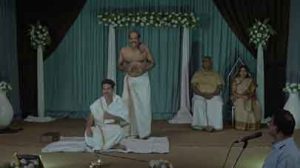 The title of the film is ironic as it refers to not just a family but the closely-knit community in the small village which follows religious rituals. In the early part of the film the entire village has turned up to attend a wedding. A barber addresses the gathering there, requesting permission from the ‘family’ for beautifying the groom! The shaving in public is followed by a dance performance by teenage girls. Some of the lines of the song for which they dance are about protecting children: “On your children who roam – Protect them keenly – With your showers of mercy, St. Thomas”. Later it’ll be known why it’s relevant to Family.
The title of the film is ironic as it refers to not just a family but the closely-knit community in the small village which follows religious rituals. In the early part of the film the entire village has turned up to attend a wedding. A barber addresses the gathering there, requesting permission from the ‘family’ for beautifying the groom! The shaving in public is followed by a dance performance by teenage girls. Some of the lines of the song for which they dance are about protecting children: “On your children who roam – Protect them keenly – With your showers of mercy, St. Thomas”. Later it’ll be known why it’s relevant to Family.
Sony, a young man has a good standing in this community. He is a math tutor for a young girl and a poetry teacher for a young boy. Sony takes initiative in rescuing a cow, laying a road and fundraising for a burial. He attends youth league meetings and helps the women and the elderly. But there is something amiss about him. Under the veneer of a do-gooder, his acts are disturbing and impact others. How will the ‘family’ address it?
THE POWER OF ELLIPSIS
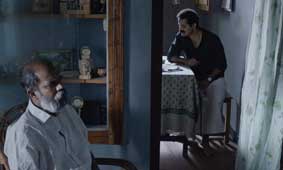 The scene in which Sony tutors a young girl in her house is shot creatively. Normally such a scene will show Sony and the girl in the foreground with an insignificant and unobtrusive background so that we can understand the foreground action clearly. This scene makes an entirely opposite approach. After showing the girl in a medium shot in her room, there is a cut to the living room. In the foreground we can see the girl’s father sitting in a cane chair and watching TV oblivious to what is happening in the room nearby. In the background the audience can see Sony sitting at a desk through the entrance of the room but the girl can’t be seen. At some point Sony gets up and goes to the other side of the desk so the audience can’t even see what’s going on. The significant action by Sony in the background is left to our imagination. It’s all the more disturbing as Sony takes advantage of the trusting father of the girl in the foreground. The gravity of the scene is deeper by withholding the main part of background action.
The scene in which Sony tutors a young girl in her house is shot creatively. Normally such a scene will show Sony and the girl in the foreground with an insignificant and unobtrusive background so that we can understand the foreground action clearly. This scene makes an entirely opposite approach. After showing the girl in a medium shot in her room, there is a cut to the living room. In the foreground we can see the girl’s father sitting in a cane chair and watching TV oblivious to what is happening in the room nearby. In the background the audience can see Sony sitting at a desk through the entrance of the room but the girl can’t be seen. At some point Sony gets up and goes to the other side of the desk so the audience can’t even see what’s going on. The significant action by Sony in the background is left to our imagination. It’s all the more disturbing as Sony takes advantage of the trusting father of the girl in the foreground. The gravity of the scene is deeper by withholding the main part of background action.
Warning: This article contains spoilers
LEOPARD ON THE PROWL
 Family opens with the conversation on the leopard between Sony riding a bike and Subin sitting behind him, announcing the recurrent leopard theme. A leopard from the adjoining forest is on the prowl. There are evidences of its presence as it preys on a calf and a chicken. But the film doesn’t show the leopard until the penultimate scene. Traps have been dug up to catch the predator but it’s a cow which gets caught in the trap and rescued. At some point we realize the connection between the leopard and the protagonist Sony. Unlike the animal which the villagers try to catch by setting up traps, Sony is “cured” and even rewarded. Finally, when we see the leopard in full view, we realize the enormity of the danger caused by the animal as well as the human beast.
Family opens with the conversation on the leopard between Sony riding a bike and Subin sitting behind him, announcing the recurrent leopard theme. A leopard from the adjoining forest is on the prowl. There are evidences of its presence as it preys on a calf and a chicken. But the film doesn’t show the leopard until the penultimate scene. Traps have been dug up to catch the predator but it’s a cow which gets caught in the trap and rescued. At some point we realize the connection between the leopard and the protagonist Sony. Unlike the animal which the villagers try to catch by setting up traps, Sony is “cured” and even rewarded. Finally, when we see the leopard in full view, we realize the enormity of the danger caused by the animal as well as the human beast.
STRUCTURE
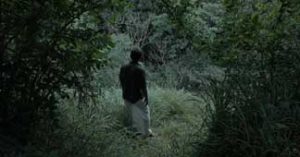 The parallel with the leopard structures Family, conveying the predatory nature of the film’s protagonist. Just as we only see the signs of the leopard’s preying, Sony’s sinister actions aren’t shown but their effects on his victims can be seen. The effort made to catch the animal contrasts with the virtual license given to Sony in the end.
The parallel with the leopard structures Family, conveying the predatory nature of the film’s protagonist. Just as we only see the signs of the leopard’s preying, Sony’s sinister actions aren’t shown but their effects on his victims can be seen. The effort made to catch the animal contrasts with the virtual license given to Sony in the end.
The film is replete with Christian imagery. Don Palathara knows his setting in his native Idukki district in Kerala well so the film looks authentic. The detached static shots with long takes have a built-in ambiguity. In a film in which the background music is minimal, the prayers and hymns in Malayalam form a recurring background on the sound track. While it’s a comment on the hold of religion on the community, there is also a spiritual aspect to these scenes.
THE GOOD SAMARITAN
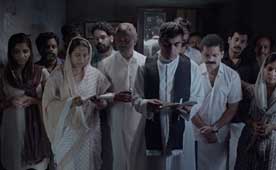 Although the film has an understated satirical tone, it is largely in the nature of presenting a phenomenon and letting any conclusion emerge out of it rather than spell it out. It’s significant that the protagonist Sony is not portrayed as a villain although his good deeds come under scrutiny. He has to be a helpful person so that he can control people to his advantage. In a well-conceived scene, Sony removes his shirt and lies down next to Subin in the bed. He admonishes Subin for his misbehaviour in the school. This scene shows how Sony has an exterior persona of somebody who is concerned about Subin’s welfare but in fact he exploits Subin’s weakness for approval in order to get physically close to him. The sensitive Subin feels bad for displeasing Sony and runs away from home for a while. In yet another notable scene, Sony goes by his father’s words and conveys to Neethu that he’s putting an end to their relationship. Sony is shown as a master manipulator who is able to derive sympathy from Neethu. She even tells him that she feels sorry for him! One person Sony can’t control is Subin’s elder brother Noby who has perhaps seen through him.
Although the film has an understated satirical tone, it is largely in the nature of presenting a phenomenon and letting any conclusion emerge out of it rather than spell it out. It’s significant that the protagonist Sony is not portrayed as a villain although his good deeds come under scrutiny. He has to be a helpful person so that he can control people to his advantage. In a well-conceived scene, Sony removes his shirt and lies down next to Subin in the bed. He admonishes Subin for his misbehaviour in the school. This scene shows how Sony has an exterior persona of somebody who is concerned about Subin’s welfare but in fact he exploits Subin’s weakness for approval in order to get physically close to him. The sensitive Subin feels bad for displeasing Sony and runs away from home for a while. In yet another notable scene, Sony goes by his father’s words and conveys to Neethu that he’s putting an end to their relationship. Sony is shown as a master manipulator who is able to derive sympathy from Neethu. She even tells him that she feels sorry for him! One person Sony can’t control is Subin’s elder brother Noby who has perhaps seen through him.
Sony may be aware of what he is doing and perhaps he looks upon religion to reform him. He listens to the advice of the nun and attends the retreat. The role of Sony is played by Vinay Forrt who comes up with an excellent performance, bringing out the complex character. Sony’s condition may be hebephilia “in which people display a sexual preference for children at the cusp of puberty, between the ages of, roughly, 11 to 14 years of age.” [1] As per this article, Humbert Humbert from Vladimir Nabokov’s masterpiece “Lolita” falls in the category of hebephile and not pedophile as this fictitious character is known. Following is a summary of some of the findings about hebephilia in [2]: Prenatal factors contribute to hebephilia. Non-righthandedness, lower IQ, lesser educational performance and short height have been found. Neurocognitive functioning is another important aspect. Suffering a head injury before the age of 13 could be a contributing factor. Disconnection in the brain network that recognizes and respond to sexual cues may cause a deviant sexual preference. Experiencing sexual abuse as a child or young adolescent increases the chance of committing sexual offence against minors in the future.
THE RETREAT
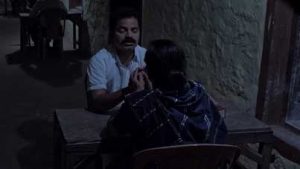 In one of the best scenes in the film, Sony’s aunt, who is a nun, silences Rani, yet another aunt of Sony, who had reason to suspect Sony of committing a grave act. In an earlier scene Rani shares her suspicion about Sony with Subin’s mother Jaya. Determined to whitewash Sony’s acts, the nun admonishes Rani, the lone sane voice. The nun has come with an alliance for him as well as a job as requested by Sony’s father in the early part of the film. In yet another remarkable scene, she advises Sony in the car to put an end to his “silliness” and takes the approach of “reforming” him by sending him to a retreat which, she claims, can cure even the incurable ones. She assures him that if he sincerely repents and prays, the lord will forgive him.
In one of the best scenes in the film, Sony’s aunt, who is a nun, silences Rani, yet another aunt of Sony, who had reason to suspect Sony of committing a grave act. In an earlier scene Rani shares her suspicion about Sony with Subin’s mother Jaya. Determined to whitewash Sony’s acts, the nun admonishes Rani, the lone sane voice. The nun has come with an alliance for him as well as a job as requested by Sony’s father in the early part of the film. In yet another remarkable scene, she advises Sony in the car to put an end to his “silliness” and takes the approach of “reforming” him by sending him to a retreat which, she claims, can cure even the incurable ones. She assures him that if he sincerely repents and prays, the lord will forgive him.
The retreat scenes with charismatic high energy preaching full of shouting hallelujah by the group followed by one-on-one counselling are also among the best in the film. Sony is being saved just like the cow which was rescued. But Sony is in fact a leopard masquerading as a cow. However, the film treats the characters with complexity. This helps in evoking empathy for them.
THE ENDING
 In the school assembly, Sony is introduced as a new teacher. The students are asked to applaud and welcome him. Halfway through the singing of the prayer song it starts raining so the students run towards the school building. The piety of the welcome for the teacher is subverted. It’s shocking that the predator is offered his prey on a platter. We realize that this is in fact a horror story. In the following scene the leopard which has only been talked about is shown in full view. It is a couple of children who happen to witness the leopard. Likewise, it’s the children who’ll come to know the leopard in Sony. He has an entire school at his disposal. The last freeze frame shows Sony with school children around, sending chills up our spines.
In the school assembly, Sony is introduced as a new teacher. The students are asked to applaud and welcome him. Halfway through the singing of the prayer song it starts raining so the students run towards the school building. The piety of the welcome for the teacher is subverted. It’s shocking that the predator is offered his prey on a platter. We realize that this is in fact a horror story. In the following scene the leopard which has only been talked about is shown in full view. It is a couple of children who happen to witness the leopard. Likewise, it’s the children who’ll come to know the leopard in Sony. He has an entire school at his disposal. The last freeze frame shows Sony with school children around, sending chills up our spines.
CINEMATOGRAPHY
 Jaleel Badusha’s camera follows a rigorous scheme of static shots with long takes which has paid off. The high angle shots in a number of scenes help in depicting the vulnerability of the characters. There is an unusual composition in which a young boy is seen sleeping in a sofa in the foreground while a mass is being performed in the background. Such a scene will usually focus only on the mass which will appear to be too carefully composed. In real life, if a child is sleepy, it’ll be put to sleep and the rest of the group will continue with its activity. This is the way it’s done in this scene in Family which makes it contrapuntal. On the other hand, the house prayer scene is carefully composed but, even in this scene, Sony is looking at the camera. Perhaps the fourth wall is broken to sensitize the audience to the presence of the wolf among the sheep which offsets the piety. The confession scene is somewhat like how employees in a company state something innocuous when they are asked to come up with their weaknesses as part of self-assessment.
Jaleel Badusha’s camera follows a rigorous scheme of static shots with long takes which has paid off. The high angle shots in a number of scenes help in depicting the vulnerability of the characters. There is an unusual composition in which a young boy is seen sleeping in a sofa in the foreground while a mass is being performed in the background. Such a scene will usually focus only on the mass which will appear to be too carefully composed. In real life, if a child is sleepy, it’ll be put to sleep and the rest of the group will continue with its activity. This is the way it’s done in this scene in Family which makes it contrapuntal. On the other hand, the house prayer scene is carefully composed but, even in this scene, Sony is looking at the camera. Perhaps the fourth wall is broken to sensitize the audience to the presence of the wolf among the sheep which offsets the piety. The confession scene is somewhat like how employees in a company state something innocuous when they are asked to come up with their weaknesses as part of self-assessment.
The long takes demand competent acting skills. Don Palathara has made sure that the acting is uniformly good in the film. Apart from Vinay Forrt who excels in the role of the protagonist Sony, Divya Prabha as Rani, Nilja K. Baby as Neethu and K.K. Indira as the nun – called sister aunty in the film – have given very good performances. Dialogues are perhaps improvised as they sound natural.
Of late, it has become very difficult to make films which are even remotely critical of any community. Kudos to Don Palathara, Sherin Catherine and Anto A Chittilappilly & Co of Newton Cinema for coming up with a perceptive film like Family on a sensitive subject in these times. While the film is set in a milieu in which Palathara grew up, the film may be taken to be depicting in general how traditional societies look upon religion as a panacea. Family was among the best films of Bengaluru International Film Festival (BIFFES) 2023. It’s also one of the best in Indian cinema in recent times.
References
- Berring, Jesse. “Pedophiles, Hebephiles and Ephebophiles, Oh My: Erotic Age Orientation”, New York, Scientific American, July 1, 2009
- Phenix, Amy and Hoberman, Harry M. “Sexual Offending: Predisposing Antecedents, Assessment and Management”, New York, Springer, 2016, pp 35-36

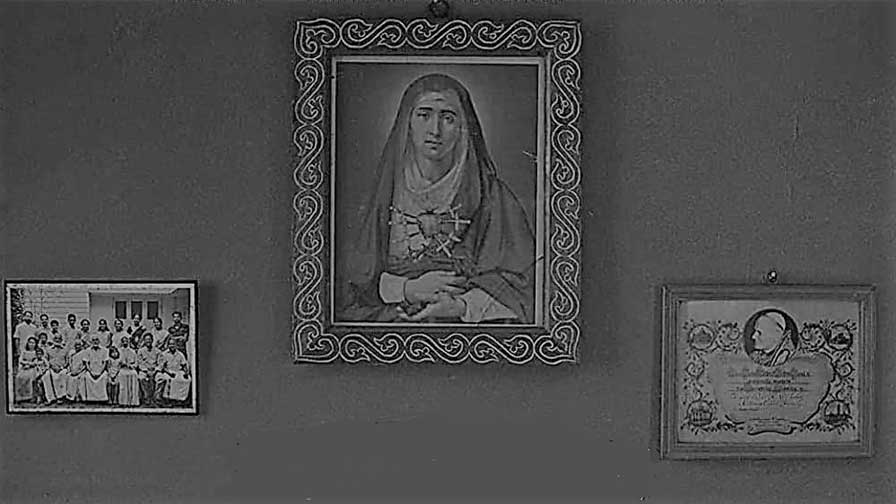

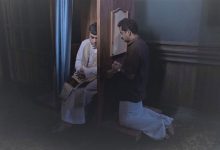


Very perceptive n balanced analysis..
Thank you Surya for your response which makes it worthwhile to write the essay!